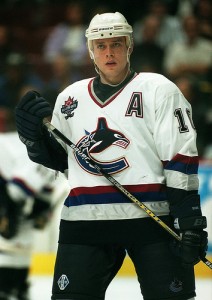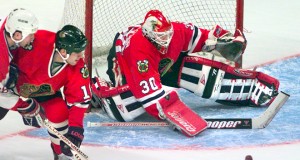Last week’s induction ceremony at the Hockey Hall of Fame saw an elite group of players granted entrance to the hall, as Joe Sakic, Adam Oates, Pavel Bure, and Mats Sundin were canonized by the church of hockey.

However, almost as if through necessity, controversy once again brewed as many disputed some of the questionable selections in the 2012 player’s class. While these four men were obviously superstars for the better part of their collective careers and undoubtedly worthy of enshrinement into the Hall of Fame, there will surely be a nucleus of fans and media pundits who disapprove of the yearly selections.
This annual controversy can stem from a myriad of reasons ranging from a belief of unworthiness or advocating for an omitted (or snubbed) player. Much of this can be attributed to the current player eligibility criteria implemented by the Hall of Fame, contained in By-Law 22, subsection 13 which states: “Candidates for election as Honoured Members in the player category shall be chosen on the basis of their playing ability, sportsmanship, character and their contribution to their team or teams and to the game of hockey in general.”
Subsection 17 continues to state: “Except as provided in paragraph 20, a candidate for election in the player category must have concluded his or her career as an active player for a minimum of three playing seasons before his or her election.” Paragraph 20 refers to the waiving of the mandatory 3-year waiting period, such as when Wayne Gretzky and Mario Lemieux were inducted.
To simplify, the only concrete criteria that players almost universally must adhere is the 3-year waiting period as subsection 13’s enforcement is left to the subjective judgement of the election committee of that year. As such, important factors such as sportsmanship, character, and contribution to their teams and hockey in general are determined without an objective guideline to reference. This undoubtedly has attributed to many of the Hall’s controversial snubs and rectifying this would do a good deal of service to eliminating discontent towards selections.
While just one of many potential suggestive rubrics, the follow criterion is proposed:
- Statistical Excellence
- International Success
- Individual Honours
- Personal Conduct
- Intangibles of Hockey

In this proposed system, a player would have to meet a minimum of three of these criteria to be Hall eligible. The first three are concrete guidelines that can be backed by factual evidence while the final two still leave room for debate among the selection committee (thus retaining both the relevance of the committee as well as healthy debate) and could prove as “X Factors” in pushing a certain player over the edge. The categories are described below, and then a case will be made for an excluded Hall of Famer based on this process.
Statistical Excellence
A very straightforward category, statistical excellence of a player can be determined by examining a career stats sheet. To make the category a whole value, it should be broken down into sub-categories. Games played, goals, assists, points, penalty minutes, and plus/minus should all be open to immediate evaluation. To account for players worthy of Hall of Fame distinction but had careers shortened by injury, points-per-game should be evaluated as an important stat as well.
International Success
Given that the Hockey Hall of Fame wishes to present itself as global and not NHL-centric, international success should undoubtedly be an important factor. Subcategories to establish an accomplished international hockey career should consist of team memberships and team accomplishments in all levels of international play. This would include the IIHF tournaments of all levels (including the under-age ranks), Canada and World Cups, and Olympic representation.
Individual Honors
This assessment has traditionally been NHL-centric, given the high profile associated with individual NHL honors such as the Hart Trophy and the Norris Trophy. This category would obviously take these into heavy consideration, but should also be broadened to include honours outside the NHL. Examples would include All-Star team recognition in international tournaments (this would be considered an individual honour as opposed to an international success), international tournament MVP selections, all-star game selections during all levels of a player’s career, and so on. This will once again be solidified evidence on which a committee member can base an argument.
Personal Conduct
This is the first of the debatable, subjective categories. Elements of this are alluded to in the aforementioned by-law when discussing

“character”, but that is obviously a vague definition. Dino Ciccarelli took years to be elected to the Hall despite being a 500-goal scorer based on an on-ice incident with Luke Richardson yet Ed Belfour can enter the Hall with publicly embarrassing alcohol related legal offences and Patrick Roy, thanks to statistical greatness, was elected quickly despite an arrest for domestic abuse. While it is not the Hall’s job to pry into the personal lives of potential inductees, public knowledge should be fair game and treated as fair criticism to prevent entry. While the failure of a player to achieve approval in this criteria will certainly not prevent them from Hall entry, an incident such as Belfour or Roy’s would eliminate this criteria from the application process in this proposed system.
Intangibles of Hockey
This is easily the most subjective category in this system but is also the most important. Not only does it allow for debate amongst the selection committee, but it allows for cases to be made for players who aren’t littered all over the offensive stats sheet- which is hockey’s easiest barometer of determining greatness. Defensive forwards and defensive defensemen would make their hay here as their contributions are often overshadowed by the game’s offensive greats. Valuable leaders would also benefit from the Intangibles category, and broaden the Hall of Fame to a more encompassing view of hockey rather than a largely offensive one. Intangibles of hockey should also include Stanley Cup Championship status, as the status of a champion represents something intangible in hockey.
To conclude, a brief case will be made for a player currently eligible for Hall of Fame enshrinement but has not been inducted likely due to their stats not striking someone as immediately impressive.
Guy Carbonneau
Statistical Excellence– Carbonneau played in 1318 games over an 18-year NHL career in which he amassed 260 goals and 403 assists, good for 663 points. This averages to a modest 0.50 points-per-game average, a relatively low number to gain Hall admittance. Despite this, his 1318 games prove that he was a useful NHL player who proved longevity.
Does player meet criteria? NO
International Success– Carbonneau did not represent his native Canada to any reputable acclaim.
Does player meet criteria? NO
Individual Honours– A premier defensive forward for the majority of his career, Carbonneau received the Frank J. Selke Trophy on 3 occasions- 1988, 1989, and 1992. This is tied for 2nd all-time with Pavel Datsyuk and Jere Lehtinen. It is one short of the record held by Bob Gainey (4), who was elected to the Hall in 1992. He was also a second-team all-star for the 1980 QMJHL season.
Does player meet criteria? YES
Personal Conduct– A perennial fan-favourite in Montreal and Dallas, his prominent NHL stops. No glaring character flaws or misconduct apparent.
Does player meet criteria? YES
Intangibles of Hockey- Carbonneau won 3 Stanley Cups with two different franchises during his career, 1986 and 1993 with Montreal and 1999 with Dallas. He served as captain for Montreal’s 1993 championship. Carbonneau was a +186 in his career, never recording a minus season worse than -9. A student of hockey, he entered the coaching realm upon his retirement and under his tutelage the Canadiens achieved a 100-point season in 2007-2008 for the first time since their 1993 Cup championship- a span of 14 years.
Does player meet criteria? YES
Conclusion: By this rubric, Carbonneau achieves 3 of the 5 criteria, as Statistical Excellence and International Success are omitted. However, his outstanding achievement in the other 3 categories include a historical impact with 3 Frank J. Selke Trophy wins while his status as an inherent winner is indicated by his 3 Stanley Cup rings with two different franchises.
Player is Hall of Fame worthy? YES